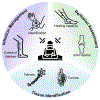Current and Future Applications of Fluorescence Guidance in Orthopaedic Surgery
- PMID: 36447084
- PMCID: PMC10106269
- DOI: 10.1007/s11307-022-01789-z
Current and Future Applications of Fluorescence Guidance in Orthopaedic Surgery
Abstract
Fluorescence-guided surgery (FGS) is an evolving field that seeks to identify important anatomic structures or physiologic phenomena with helpful relevance to the execution of surgical procedures. Fluorescence labeling occurs generally via the administration of fluorescent reporters that may be molecularly targeted, enzyme-activated, or untargeted, vascular probes. Fluorescence guidance has substantially changed care strategies in numerous surgical fields; however, investigation and adoption in orthopaedic surgery have lagged. FGS shows the potential for improving patient care in orthopaedics via several applications including disease diagnosis, perfusion-based tissue healing capacity assessment, infection/tumor eradication, and anatomic structure identification. This review highlights current and future applications of fluorescence guidance in orthopaedics and identifies key challenges to translation and potential solutions.
Keywords: Fluorescence-guided surgery; Indocyanine green imaging; Meniscus tear; Necrotizing soft tissue infection; Nerve imaging; Tissue-simulating phantoms; Tumor imaging.
© 2022. The Author(s), under exclusive licence to World Molecular Imaging Society.
Conflict of interest statement
S. Streeter is a part-time employee of QUEL Imaging LLC, a Small Business Innovation Research-funded start-up that focuses on the commercialization of optical targets for fluorescence guided surgical systems. S. Gibbs is a co-founder and stockholder of Trace Biosciences, a start-up company focused on the development and clinical translation of nerve-specific probes for FGS. S. Gibbs also has three patents pending related to this work (US No. 62/711,465, US No. 62/729,932, and US No. 62/956,614). E. Henderson is an educational consultant for Stryker Orthopaedics. All other authors declare no competing interests.
Figures







References
-
- Paraboschi I, Farneti F, Jannello L, Manzoni G, Berrettini A, Mantica G (2022) Narrative review on applications of fluorescence guided surgery in adult and pediatric urology. AME Med J 7:15. 10.21037/amj-20-194 - DOI
Publication types
MeSH terms
Substances
Grants and funding
LinkOut - more resources
Full Text Sources
Medical

